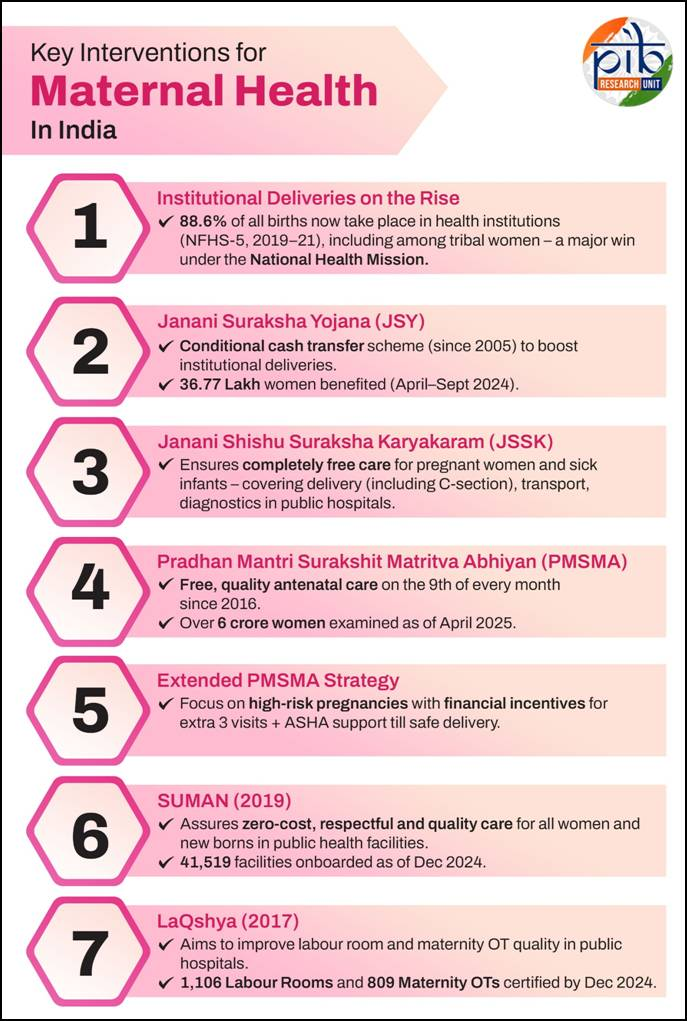Syllabus: GS2/Health
Context
- World Health Day, observed annually on 7 April, highlights pressing global health issues and mobilises action to improve public health outcomes.
About
- It was founded by WHO in 1950.
- The idea for World Health Day originated from the first World Health Assembly, held in Geneva, Switzerland, in 1948.
- It is aimed at uniting governments, institutions, and communities to address global health priorities.
- 2025 Theme: “Healthy Beginnings, Hopeful Futures” focuses on maternal and newborn health, urging countries to reduce preventable deaths and prioritize women’s long-term well-being.
- India’s Commitment: The Ministry of Health and Family Welfare, strengthens efforts for equitable, accessible, and quality healthcare.
- According to WHO, close to 300,000 women lose their life due to pregnancy or childbirth each year, while over 2 million babies die in their first month of life and around 2 million more are stillborn.
- Based on current trends, 4 out of 5 countries are off track to meet targets for improving maternal survival by 2030.
India’s Maternal Mortality and Child Mortality
- MMR (Maternal Mortality Ratio) in India dropped from 130 (2014-16) to 97 (2018-20) per 1,00,000 live births – a decline of 33 points.
- Infant & Child Mortality: IMR (Infant Mortality Rate) dropped from 39 (2014) to 28 (2020) per 1,000 live births.
- NMR (Neonatal Mortality Rate) reduced from 26 (2014) to 20 (2020) per 1,000 live births.

Challenges in India’s Healthcare
- Limited Access to Healthcare: Rural and remote areas often lack sufficient healthcare facilities and trained professionals.
- Poor Infrastructure: Inadequate medical infrastructure, including hospitals, equipment, and sanitation, especially in underserved regions.
- High Disease Burden: India faces a heavy burden of both infectious and non-communicable diseases, requiring diverse healthcare solutions.
- Financial Barriers: High out-of-pocket expenses for healthcare, leading to financial strain on low-income families.
- Inequality in Healthcare Access: Disparities in healthcare access based on geography and socioeconomic status.
- Shortage of Skilled Workforce: Insufficient number of healthcare workers, including doctors, nurses, and specialists.
- Fragmented Health System: Lack of integration and coordination between public and private health sectors.
Government Initiatives
- Maternal Death Surveillance and Response (MDSR): Conducted at facility and community levels to identify causes of maternal deaths and implement corrective actions for improving obstetric care.
- Reproductive and Child Health (RCH) Portal: A name-based digital platform to track pregnant women and newborns, ensuring timely antenatal, delivery, and postnatal care.
- Anaemia Mukt Bharat (AMB): Part of POSHAN Abhiyan; focuses on testing, treatment, and prevention of anaemia in adolescents and pregnant women.

- National Health Mission (NHM): Focused on improving maternal and child health, expanding digital health access, and enhancing infrastructure and services.
- The Ayushman Bharat Digital Mission (ABDM) is a unified digital health ecosystem to securely connect patients, healthcare providers, and systems through an interoperable digital infrastructure.
- Disease Elimination & Control: India’s major strides in malaria elimination, with a 69% drop in cases and 68% reduction in deaths between 2017 and 2023.
- India has eliminated Trachoma as a public health problem in 2024.
- Under the National Tuberculosis Elimination Programme (NTEP), TB incidence fell by 17.7% between 2015 and 2023.
- India has successfully achieved Kala-azar elimination as of 2024.
Conclusion
- Maternal and newborn health is crucial for several reasons, as it directly impacts the well-being of mothers, infants, families and communities.
- Prioritizing regular health check-ups throughout pregnancy can help with early detection and management of potential complications.
- India’s advancements in public health, especially in maternal and child care, reflect a strong commitment to equitable and inclusive healthcare.
Source: PIB
Previous article
Land Subsidence in Urban Areas